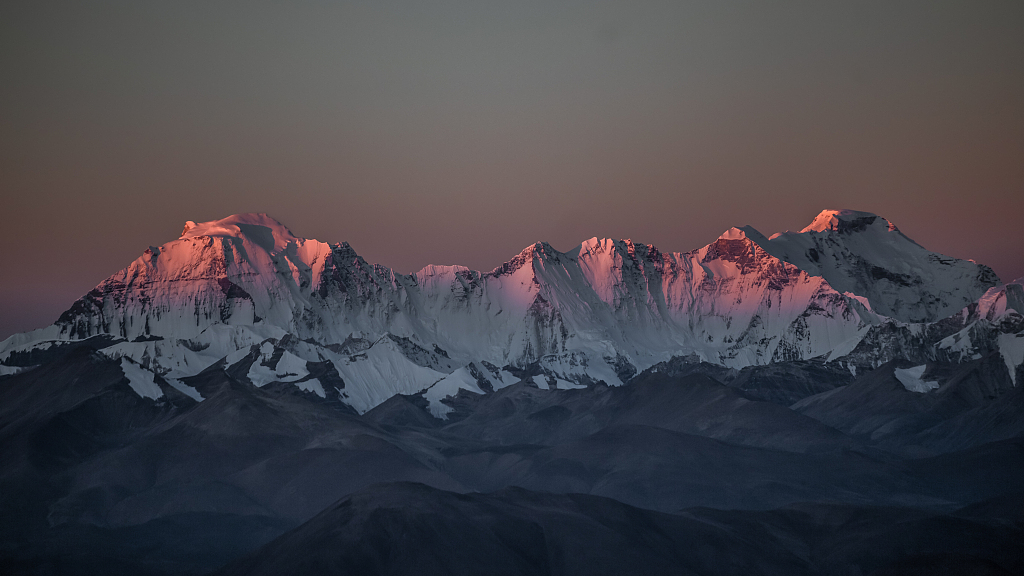Up along the path from an altitude of 4,950 meters on Mount Cho Oyu, the world's sixth-highest mountain, some fragments of rocks with metal luster shone by the roadside.
"The rock samples here contain rare metal elements and the samples from different altitudes can help us understand the distribution layers of rare metals here," said Liu Xiaochi, an associate researcher from the Institute of Geology and Geophysics at the Chinese Academy of Sciences (CAS).
Liu's expedition team reached the peak of Mount Cho Oyu, also known as Mount Qowowuyag, last Sunday to systematically collect rock samples for the first time in history, hopefully to reveal more about the formation of the Himalayas.
Unlike rock samples, which were easily collected on the surface by Liu at the foot of the mountain, rock samples in the peak area were covered deep under snow and ice, making collection extremely difficult.

Scenery of Mount Cho Oyu in Xizang Autonomous Region's Xigaze City. /CFP
Scenery of Mount Cho Oyu in Xizang Autonomous Region's Xigaze City. /CFP
Wangdu, a member of the expedition team, collected rock samples from the peak downward every 50 meters in altitude with his hand and hammer after their summit.
"Each rock sample collection took me about several minutes," he said.
"Data of the rock samples from Mount Cho Oyu had been vacant until 2018, when a team from China University of Geosciences collected samples from 5,700 to 6,400 meters. However, the data was not comprehensive and poorly preserved," said Wu Fuyuan, the academician with the CAS.
"A systematic rock sample expedition like this time is necessary," he said. "We can see the distribution layers of rare metals in the area of Mount Cho Oyu and the uplift history of the Himalayas through the rock samples."
Of the 14 mountains in the world that are over 8,000 meters above sea level, China's scientists have only collected complete rock samples of Mount Qomolangma, the world's highest peak.
Scientists said that the systematic collection and comparison of rock samples from peaks over 8,000 meters above sea level in the Himalayas can provide more adequate data support for understanding the formation process and specific structures of the Himalayas.
The scientific expedition team collected a total of 60 rock samples from the top to an altitude of 5,400 meters, as well as the surrounding areas of Mount Cho Oyu, said Liu, adding that samples will be brought back for further analysis.

The scientific expedition team collects a total of 60 rock samples. /CFP
The scientific expedition team collects a total of 60 rock samples. /CFP
Besides rock samples, scientists have also carried out other sample collection activities in the area.
Su Tao, a 41-year-old researcher from the Xishuangbanna Tropical Botanical Garden of the CAS, has discovered some well-preserved coniferous plant fossils near Gangkar Town in Dingri County of Xizang Autonomous Region's Xigaze City at the foot of Mount Cho Oyu.
"We have collected more than 2,000 samples over the years in the Himalayas," said Su. The coniferous plants adapting to tropical environments with low altitudes show a radical change in the current high and cold natural environment in the areas due to the uplift of the Himalayas.
At the very beginning, all the upper, central and lower regions in the areas of Xizang were submerged under the sea. Research has revealed that the Qinghai-Xizang Plateau gradually emerged to approximately 2,000 meters above sea level, and there were dense forests of conifer and flat trees on the plateau.
As a result of the emerging and still-emerging Himalayas blocking the warm air from the Indian Ocean, the climate of the Qinghai-Xizang plateau and its surrounding areas changed and became a cold place, according to accepted research.
(If you have specific expertise and want to contribute, or if you have a topic of interest that you'd like to share with us, please email us at nature@cgtn.com.)
Source(s): Xinhua News Agency